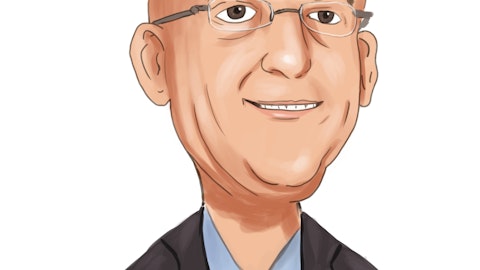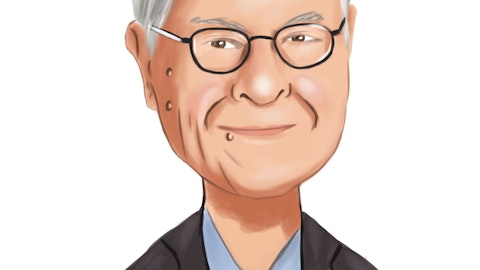Lasse Petterson: So it’s been, Q1, I mean, January particular, it did just kind of follow on through December, when we made our adjustments at the end of the year, when you kind of estimate from a job we did up our weather impact, it has turned out to be pretty severe. The expectation is that we won’t have as much of an impact because we adjusted the estimates at year end, but January was still pretty nasty. So it’ll have some impact. But my expectation is not as big of an impact as they had in Q4.
Jon Tanwanteng: Okay. Do you have a scheduled liquidation of backlogs for the quarter? And is that adjusted for weather?
Lasse Petterson: I’m sorry, can you repeat that?
Jon Tanwanteng: Do you have a backlog liquidation schedule for this quarter? And is weather factoring into that?
Lasse Petterson: It is, it is. It’s all been adjusted based on our best estimate after we saw the December, weather issues that we had.
Jon Tanwanteng: Okay, you frequently provided that number to investors. Would you care to do that today?
Lasse Petterson: I gave the quantity as far as how many days worked down? The impact? I’m not going to quantify I can tell you, it was well above the way that we had estimated the weather on these jobs when we first put in the bid 40% downtime on these jobs is unusual.
Jon Tanwanteng: I’m sorry, I meant that the revenue you expect to generate in the quarter from backlog. That’s the number we’re looking for.
Lasse Petterson: So all, we don’t have any — if where you’re going with it, we’re not assuming any additional revenue on top of what we have in backlog for Q1. So, but again, I’m not going to give a revenue number for this quarter or going forward.
Jon Tanwanteng: Okay. Understood. Second, I was just wondering if you could give us a little bit more color on how you expect your revolver draw to progress through the year just based on your expectations for margin. And obviously, what’s in backlog and their release schedule? How much — can we expect to see just in terms of drawdown at the worst as you start finding these shifts? And is there a schedule for CapEx that makes any one quarter worse than any other?
Lasse Petterson: Yes, so, again, I’m not going to give what my expected draw is going to be. I will however, kind of give you a cadence of the way the CapEx is flowing. Q1 is the heaviest CapEx quarter by a long shot. You saw that our full year 2022 CapEx was under what we were expecting. And that’s because some of the Q4 payments got pushed into Q1. So of that $175 million that I guided to for the full year, I think $70 million to $75 million. Again, these are fluid, they can move left or right, but you will see the largest amount, then Q2 is fairly light. And then the remaining balance kind of gets split equally between Q3 and Q4.
Jon Tanwanteng: Okay, great. Thank you. Lasse, do you have a expected bid market for this year? Last year was obviously a lot lower than expected. What once you do have a forecast for that intuitive, what’s your confidence level being there?
Lasse Petterson: Yes, the overall bid market for last year came out somewhat less than what we had in 21. What really was the impact on us was the lateness of the bidding. There was very little bids issued for 4.5 months in addition to the two last one, so 2021, where there was no bid issued. So that delayed or let’s say revenue stream for us on booking burn. There was a lot of bids issued in June and July, and then it tapered off again. And the big impact was really the change of the mix. The capital projects for port deepening’s that we thought was already teed up by the Corps to be issued did not happen. And they were delayed into 2023. So the Corps has now a very good budget for the year, we have the additional appropriation.
So as that was done, which will fund beach restoration in the southeast. I have very high confidence actually on the bid market for 2023. Based upon those facts. There’s nothing certain in this world, but it certainly looks we’re going to have a good bid market capital projects. I think the LNG projects, one or two of those would go to fit. So I’m optimistic.
Scott Kornblau: And Jonathan, let me just put a little more color on that. We talked about — the slowness at the beginning losses, right, it was really this mix. If you look at the course capital budget, in 2022, or I’m sorry, the bids in 2022, on capital projects of the Corps, compared to 2021 2022, 38% of the levels in 2021. Now, again, the good news is these jobs didn’t go anywhere. They are just pushing into this first half of the year, but it was pretty severe on that mix of project from what we were expecting.
Jon Tanwanteng: Okay, great. I’ll jump back in queue. Thank you.
Operator: Our next question comes line of Joe Gomez from Noble Capital, your line is open.
Joe Gomez : Thank you. Good morning. And thanks for taking my questions. So just, one of the things we had talked about previously, and I think you touched on it a little bit, maybe you get some more color, with Hurricane Ian and the impact. And you had talked about, how quickly some of those replenishment and jobs might come out? I mean, how are you seeing those today? Are you seeing a fair number of opportunities to help restore the beaches? That were impacted by the hurricane?
Lasse Petterson: Yes, I think on the last call, we’d commented that would be a flurry of projects for the South East, coming to bid here and mid this year, mid-2023. And that is then funded by the additional billion that was put through Congress. So I expect these beach renourishment and coastal protection projects to come to the bid market to let’s call it to mid-year and then come to execution during Q3 and Q4 and I don’t want to say into 2022.
Joe Gomez: Okay, thanks for that. I’ve been reading a number of articles here on offshore wind. And, they’ve been quoting that some poor economics and the technology has really negatively impacted people in here, Siemens stating that really need a lot more government action and subsidies to start to continue some of these projects, GE supposedly reporting a big loss, in its wind turbine business. Supposedly, somebody’s looking to try and get out of a project in New Hampshire. So just trying to get a better feel of what you see is the kind of the status, the status right now, in the offshore wind, now we are starting to see maybe some obstacles come up, that had not been anticipated previously.
Lasse Petterson: Yes, I don’t want to comment on our clients plans for their projects. But I can comment on the activity that we see in the market. And we as you know, we already have one firm contract with Equinor MVP. We do have not seen any diminishing activity in the request for estimates and bidding and also requirements for reservation agreements for our vessel. So the activity in the market doesn’t match. Really, I don’t see the say, any delay impacting what we do with our vessel and the bids that we are involved in. Yes, you are correct. The turbine manufacturers are suffering from low margins. And also there are some supply chain issues, which leads to delays. But the projects that we have been addressing seems to be moving forward.
Joe Gomez: Okay, great. That’s some good news. Thank you for that. And then just given the drawdown or what you’re expecting to draw down on the credit line, Scott, any, can you give us any kind of indication of where you see interest expense? Kind of how that’s going to play out for this year?
Lasse Petterson: Yes, Joe, that no, no, I don’t give you the over the draw. But I’ll tell you that the beginning part, the half, first half of the year will be hired drawn the first quarter particular, because of the way that the CapEx is weighted, and that it will, it will trickle down, so I mentioned the draw that we have, don’t extrapolate or straight line that for the rest of the year, that’s not how we’re seeing it was going to be very heavy in Q1, and then definitely the diminishing down. As you recall, we did upsize the revolver last year. So there is ample availability on there right now. We also did it at a time we’re able to get very favorable terms. We’re still borrowing today at 6%. So, it’s very manageable, the way we kind of see the cadence of the drive this year and the interest burden that will come from it.
Joe Gomez: Okay, great. Thanks for taking my questions.
Operator: Our next question comes line of . Your line is open.
Unidentified Analyst : Hi, thanks for taking the questions. Can you just help us understand where we stand with our lenders, as it relates to the covenants just give us an update there in terms of what covenants we’re dealing with? And based on the commentary you gave us, it seems like we’re going to need some help to kind of bridge us through some lower levels of profitability over the course of 2023. And then I have some follow ups.
Lasse Petterson: Yes, so on the notes that are due in 2029, there are no covenants, it’s unsecured 5.25%. So that was the revolver. Also. It has no hard covenants it does have a springing covenant that springs when availability on the revolver is less than 12.5%. It’s a fixed charge coverage ratio, that with the new build program, we likely won’t meet for the next couple of years. Once if availability becomes less than 12.5%, we do that test. If we don’t pass the test, it caps the availability at the 87.5%. That’s the only covenants we have and neither one of them.
Unidentified Analyst : Okay, and then can you give us a little bit more color on the Dot financing? I think this was something that was discussed previously, a couple quarters ago. What type of rate we’ll be looking at on that type of financing or kind of term would you be thinking about?
Lasse Petterson: Yes, and what we had talked about last year was actually a different program. It was through the DOE. This is different through . Earlier in the year, June, July or so last year is when they deemed the offshore wind free and the vessel like ours as a vessel of national interest. So it really then became very attractive. If you go out to their website and play around, it does show that they are quoting rates, that 10-year Treasury plus 37.5 basis points is tenors, up to 25 years, that is what our application had asked for. And it’s very low to no amortization. So, again, very attractive, backed by the government again, as they’re trying to really encourage investment in this. The application was submitted a few weeks ago, as I said this, this will take some time.
It’s a Q3, Q4 points that I think we know but we are having what I would call a very good dialogue with them already after we put in their application and we’ll continue to work on it with them.





